Halloween is a popular holiday festival celebrated on October 31st, every year in the US, Ireland, England, and Canada. It is one of the oldest holidays in the world and is considered to be the second most successful commercial holiday in the US after Christmas. This holiday is also known by many different names such as Snap-Apple Night, All Hallows’ Eve, Witches Night, etc. With the roots of its origin dating back thousands of centuries ago, Halloween borrows its traditions and practices from many different cultures.
Also Read, Top Kids Bookstores In Delhi NCR

Why Do We Celebrate Halloween & What Are The Halloween Traditions?
1. Where Was Halloween Originated?

Origins of Halloween
Halloween is believed to have originated around 2,000 years ago. The ancient Celtic people in Europe celebrated the end of summer and harvest every year on October 31st. This festival was called Samhain (pronounced “sow-win”). On the night of October 31st, the Celts believed that ghosts of their dead would come back to visit the Earth and therefore large bonfires were lit in villages to ward off evil spirits.
By 43 AD, the Romans conquered most of the Celtic territory and brought their festivals with them. However, a few centuries later, November 1st came to be celebrated as All Saints’ Day or All Hallows’ Day to honor some saints. And October 31st was celebrated as All Hallows’ Eve, which later became Halloween.
Did You Know?
Celts were people that mostly lived around the area that is now Ireland, the UK, and northern France.
2. What Are The Famous Halloween Traditions?
There are many popular traditions of Halloween that people celebrate with full zest and zeal. A lot of these rituals have interesting stories behind them, let’s find out-
Scary Costumes

Halloween is synonymous with scary and crazy Halloween costumes. And the tradition was started by the Celts during Samhain, to ward off evil spirits and confuse the ghosts. The people would dress up in scary costumes to scare away the ghosts. Slowly and steadily wearing scary and weird Halloween costumes became an integral part of Halloween.
Carving Jack-O-Lanterns

Jack-o-Lanterns originated in Ireland and were originally made using turnips. According to an Irish folktale, a man named Stingy Jack was condemned to wander the Earth as a ghost. He was given a carved-out turnip with a lump of coal to light his way. The locals then started carving frightening faces into their turnips to scare the evil spirits. Today, the carving Jack-o-Lanterns have become a staple of the Halloween festival. People in the US carve pumpkins and use them as decoration outside their houses.
Going Trick-or-Treating

It is believed that during the festival of Samhain, Celtic people would keep food out to please the wandering souls and ghosts. Eventually, people began dressing up as ghosts and demons and went door-to-door performing songs in exchange for food and drink. It is also believed that children and poor adults would go door-to-door to collect food and money in return for prayers said for the dead. This eventually evolved into the present-day custom of trick-or-treating. Today, kids go door-to-door dressed up in their Halloween costumes asking for candies.
Decorating With Black and Orange

Black and orange are Halloween theme colors. From decorations to costumes, mostly everything on Halloween is in black and orange. These classic Halloween colors also find their origins back to the Celtic festival of Samhain. Black signifies the “death” of summer and orange represents the color of the crops and the autumn harvest season.
How To Throw A Halloween Party?

If you want to throw a Halloween party for your friends all you need is the following items:
- A fun costume, you could turn into any of your favorite cartoon, movie, or comic characters like Superman, Spiderman, or Bugs Bunny. Or simply throw over a white bedsheet and turn into a cute ghost.
- Decorate the party area with orange and blue items like balloons, colored charts, curtains, bedsheets, etc.
- Grab a small container and go trick-or-treating with your friends.
- Watch a scary movie with your friends and family.
- Learn to carve a spooky pumpkin with your friends.
- Lastly, remember to have lots of fun!
DID YOU KNOW?
- The fear of Halloween is called Samhainophobia.
- In China, a festival similar to Halloween is celebrated. It is called the Hungry Ghost Festival.
- Mexicans celebrate Día de Muertos, a three-day festival from October 31 to November 2. This festival is similar to Halloween and is also called the Day of the Dead.
- The word “witch” comes from the Old English word wicce, meaning wise woman.
- Until the 1950s, candy was not given to trick-or-treaters. A long time ago, trick-or-treaters were handed pieces of cake, nuts, fruits, coins, and little toys.
Watch Full Video On, Meet the 8-Year-Old Braveheart Who Said Hello To Everest











